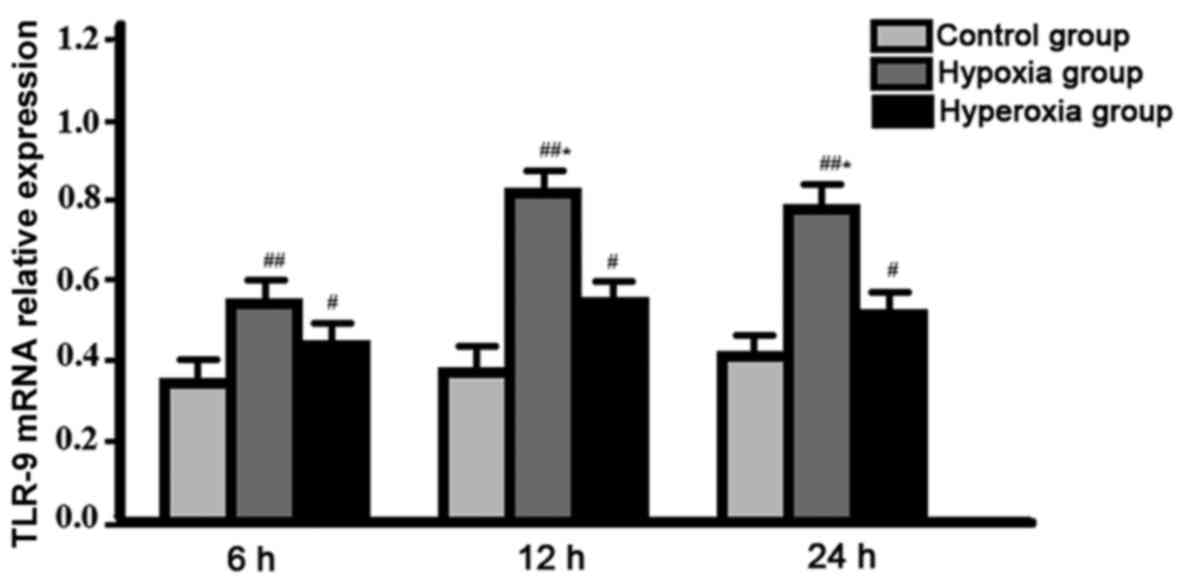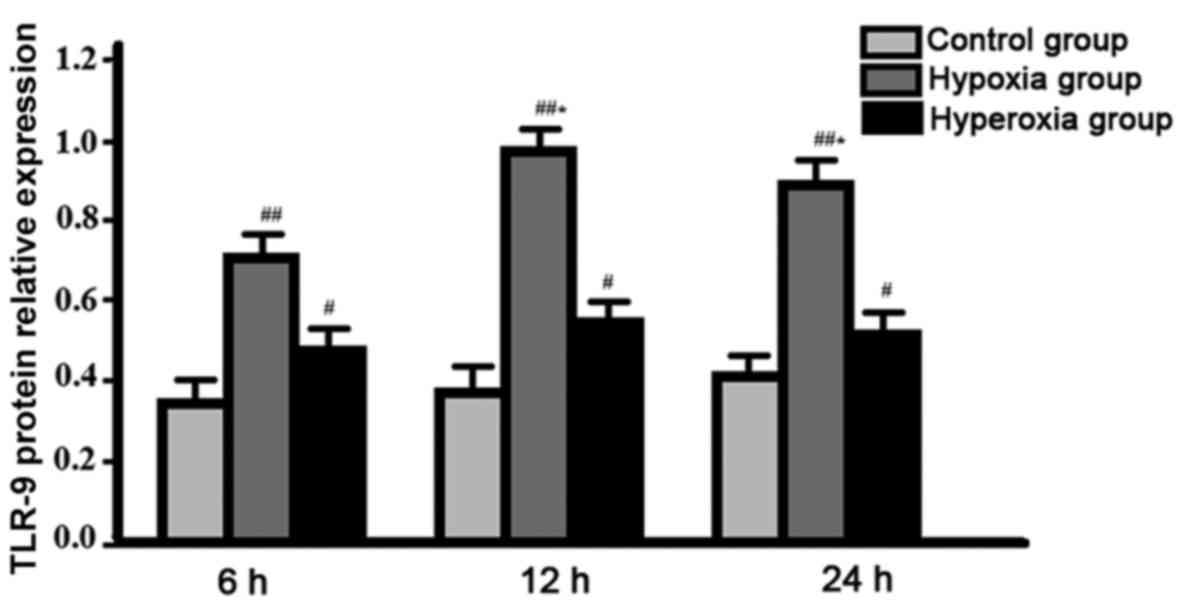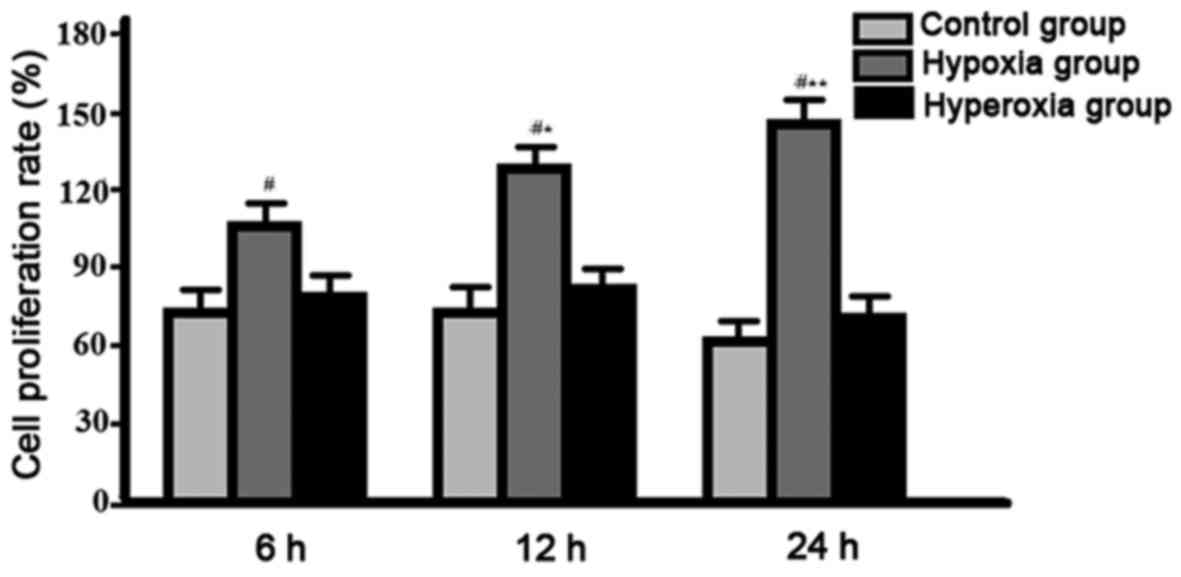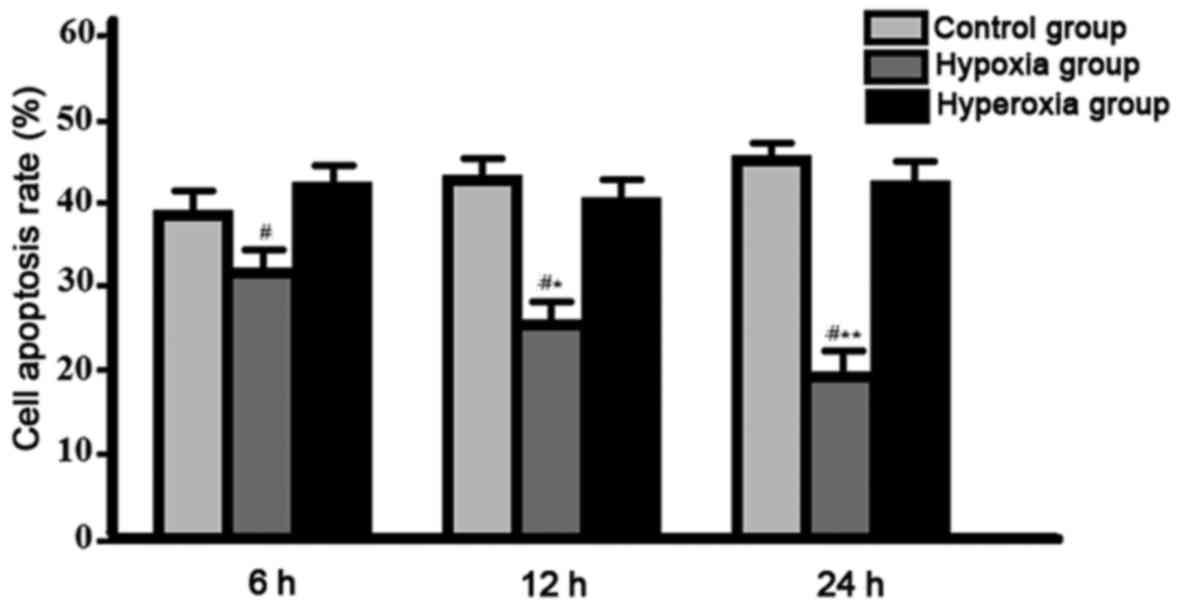Toll-like receptor-9 in hypoxic nasopharyngeal carcinoma cells and its correlation with cell proliferation and apoptosis
- Authors:
- Published online on: October 20, 2017 https://doi.org/10.3892/ol.2017.7235
- Pages: 7829-7832
-
Copyright: © Zhang et al. This is an open access article distributed under the terms of Creative Commons Attribution License.
Abstract
Introduction
Nasopharyngeal carcinoma is a radiotherapy-sensitive tumor, but with the extension of radiotherapy, the percentage of hypoxic cells gradually increased (up to 10 to 50%), and the increased percentage of hypoxic cells can lead to the failure of solid tumor chemotherapy, the recurrence and metastasis of tumors (1). Tumor cell hypoxia on the one hand can reduce the production of oxygen free radicals, resulting in reduction in radiotherapy-induced DNA breakage, on the other hand can increase the release of hypoxia-inducible factor-1 (HIF-1), increase the expression of vascular endothelial growth factor (VEGF), and inhibit tumor cell apoptosis (2). Therefore, the use of hypoxic cytotoxic drugs combined with radiotherapy and chemotherapy can improve the efficacy of cancer treatment. Toll-like receptor (TLR), as an important component of innate immunity, is related to the pathogenesis of nasopharyngeal carcinoma, breast cancer, pancreatic cancer, basal cell carcinoma and other malignant tumors (3,4). TLR-9/myeloid differentiation factor 88 (MyD88) signaling pathway can activate inflammatory and immune responses (5), mediate cell proliferation and apoptosis regulated by nuclear transcription factor (NF-κB) (6), stimulate the secretion of matrix metalloproteinases and integrins, and induce tumor cell invasion and metastasis (7). Based on this, we investigated the correlation between the expression of Toll-like receptor-9 (TLR-9) and cell proliferation and apoptosis in hypoxic nasopharyngeal carcinoma cells.
Materials and methods
Experimental materials
Human nasopharyngeal carcinoma cell line HNE-1 (EBV positive) and CNE-1 (EBV negative) were purchased from Sangon (Shanghai, China). Occurrence of nasopharyngeal carcinoma is closely related to EB virus infection, so both EBV-positive and -negative cell lines were used. Cells were cultured with RPMI-1640 cell culture medium (Beyotime Biotechnology, Jiangsu, China) containing 10% fetal bovine serum, 100 U/ml penicillin and 40 U/ml gentamicin in an incubator (37°C, 5% CO2). Cell recovery and subculture were performed using the same method. Cells were collected at logarithmic growth phase for following experiments.
Experimental methods
Cells were divided into normal control group, hypoxia group and hyperoxia group. Hypoxic conditions were 5% CO2 and 0.01% partial pressure of oxygen, hyperoxia conditions were 5% CO2 and 10% partial pressure of oxygen. After culture for 6, 12 and 24 h, cells in hypoxia group and hyperoxia group were cultured in normoxic condition for another 4 h. RT-PCR and western blot analysis were used to detect the expression of TLR-9 mRNA and protein at 6, 12 and 24 h after the beginning of cell culture. 3-(4,5-Dimethylthiazol-2-yl)-2,5-diphenyltetrazolium bromide (MTT) assay was used to detect the cell proliferation rate and flow cytometry was used to detect the cell apoptosis rate.
Detection method
RT-PCRTotal RNA was extracted by 1 ml of TRIzol reagent (Beyotime Biotechnology, Jiangsu, China). The purity and concentration of RNA samples were checked by 1.5% agarose gel electrophoresis and UV spectrophotometer (HyClone, Logan, UT, USA). cDNA was synthesized using 2 µg total RNA and reverse transcription kit (Sigma, St. Louis, MO, USA). Primers were designed by Sangon (Shanghai, China) accroding to the gene sequences downloaded from GenBank. The following primers were used: TLR-9 forward, 5′-GGTTTCATCCAGGATCGAGCAGG-3′ and reverse, 5′-ACAAAGATGGTCACGGTCTGCC-3′; endogenous control GAPDH forward, 5′-CGCGAGAAGATGACCCAGAT-3′ and reverse, 5′-GCACTGTGTTGGCGTACAGG-3′. The PCR reaction system was: 2 µl of cDNA + 3 µl of each primer + 0.5 µl of Taq polymerase (Sigma) + 1 µl of dNTPs + 2 µl of 10X buffer, water was added to make a final volume of 20 µl. Reaction conditions were 95°C for 5 min, followed by 30 cycles of 95°C for 30 sec, 58°C for 30 sec and 72°C for 60 sec, and 72°C for 10 min. PCR product (6 ml) was subjected to 2% agarose gel electrophoresis, and results were checked and pictures were taken using a gel imaging system. The grey scale values were analyzed.
Western blot analysisRIPA lysate (Beyotime Biotechnology) was added to extract total protein, and BCA quantitative kit (Beijing Zhongshan Golden Bridge Biology Co., Ltd., Beijing, China) was used to quantify protein, and β-actin was used as endogenous control for normalization. Thirty micrograms of protein from each sample was subjected to 8% sodium dodecyl sulfate-polyacrylamide gel electrophoresis (SDS-PAGE) electrophoresis, followed by transmembrane to PVDF membrane. Membrane was then incubated with mouse anti-human TLR-9 monoclonal primary antibody (dilution, 1:500; cat. no. 12-9099-82; Thermo Fisher Scientific Inc., MA, USA) or mouse anti-human β-actin primary antibody (dilution, 1:2,000; Sigma-Aldrich, Inc., MA USA) overnight at 4°C. After washing, membranes were incubated with goat anti-mouse polyclonal secondary antibody (1:500; Sigma-Aldrich, Inc.) at room temperature for 4 h. After washing with PBS, color development was performed with ECL. Results were scanned and recorded. Lab Works 4.5 gel imaging software (Invitrogen, Carlsbad, CA, USA) was used for semi-quantitative analysis.
MTTCells were resuspended to make a concentration of 2×106/ml and transferred to a 96-well plate with 100 µl for each well. After incubation for 6, 12 and 24 h, 10 µl of 5 mg/ml MTT (Bio-Rad, Hercules, CA, USA) was added to each well, followed by incubation for another 4 h. Culture medium was discarded and 150 µl of dimethyl sulfoxide (DMSO; Bio-Rad) was added to each well and shaken for 10 min. Optical density (OD) at A490 nm was measured by a microplate reader (Bio-Rad). OD values were measured 3 times and the average value was calculated. Cell proliferation rate = sample/control OD value ×100%.
Flow cytometryCells were centrifuged at 1,500 × g for 10 min to remove the supernatant. After washing with PBS, cells were collected. Cells were mixed with 100 µl of binding buffer and 10 µl of FITC-labeled Annexin V (20 µg/ml) (both from Beyotime Biotechnology), followed by incubation at room temperature for 30 min. After that, 5 µl of propidium iodide (PI, 50 µg/ml; Beyotime Biotechnology) was added and incubated at room temperature for 5 min. After that, 400 µl of binding buffer was added and detection was performed within 1 h. Cell solution without Annexin V-FITC and PI was used as negative control. FACSCalibur flow cytometry (BD Biosciences, Lake Franklin, NJ, USA) was used here.
Statistical analysis. Statistical analysis was performed using SPSS 20.0 software (SPSS Inc., Chicago, IL, USA). Measurement data were expressed as mean ± standard deviation, comparisons among multiple groups were performed using single factor ANOVA analysis, comparisons between two groups were performed using LSD-t method, and comparisons between different time-points were performed using analysis of variance of repeated measure data. P<0.05 was considered to be statistically significant.
Results
Comparison of expression level of TLR-9 mRNA between groups. Expression level of TLR-9 mRNA in hypoxia group reached the peak at 12 h after the beginning of cell culture, and was significantly higher than that of hyperoxia group at all time-points, control group was the lowest, difference between groups were all statistically significant (P<0.05). No significant changes in expression level of TLR-9 mRNA were found in control group and hyperoxia group between different time-points (P>0.05) (Fig. 1).
Comparison of expression level of TLR-9 protein between groups. Expression level of TLR-9 protein in hypoxia group reached the peak at 12 h after the beginning of cell culture, and was significantly higher than that of hyperoxia group at all time-points, control group was the lowest, difference between groups were all statistically significant (P<0.05). No significant changes in expression level of TLR-9 protein were found in control group and hyperoxia group between different time-points (P>0.05) (Fig. 2).
Comparison of cell proliferation rate among groups. Compared with other two groups, cell proliferation rate was gradually decreased in hypoxia group, significant differences were found between hypoxia group, and control group and hyperoxia group (P<0.05), no significant differences were found between control group and hyperoxia group (P>0.05) (Fig. 3).
Comparison of cell apoptotic rate among groups. Compared with other two groups, cell apoptotic rate was gradually decreased in hypoxia group, significant differences were found between hypoxia group, and control group and hyperoxia group (P<0.05), no significant differences were found between control group and hyperoxia group (P>0.05) (Fig. 4).
Discussion
Studies have shown that solid tumors can overexpress HIF-1α in hypoxic microenvironment and regulate the expression of a series of genes that are compatible with hypoxia to maintain metabolic stability and promote tumor growth and metastasis. HIF-1α can exert anti-apoptotic and pro-apoptotic effects simultaneously, HIF-1α can increase the anaerobic metabolism and glucose extraction, and downregulate the expression of apoptotic genes to play an anti-apoptotic role (8); at the same time, HIF-1α can increase the level of p53 protein by inhibiting its degradation to play a pro-apoptotic role (9). Therefore, how to regulate HIF-1α to increase tumor cell apoptosis is an important task for studies on treatment of tumors.
This study showed that expression levels of TLR-9 mRNA and protein in hypoxia group reached the peak at 12 h after the beginning of cell culture, and were significantly higher than those of hyperoxia group at all time-points, expression levels of TLR-9 mRNA and protein of control group were the lowest, differences between groups were all statistically significant (P<0.05). No significant changes in expression levels of TLR-9 mRNA and protein were found in control group and hyperoxia group between different time-points; compared with other two groups, cell proliferation rate was gradually decreased and apoptotic rate was gradually decreased in hypoxia group, significant differences were found between hypoxia group, and control group and hyperoxia group, but no significant differences were found between control group and hyperoxia group, indicating that hypoxic nasopharyngeal carcinoma cells can highly express TLR-9 to regulate cell proliferation and apoptosis, which may be an important mechanism of tumorigenesis and a potential target for intervention therapy.
Clinical study of nasopharyngeal carcinoma showed that (10,11), expression level of TLR-9 was significantly higher in tumor cells than in adjacent normal tissue and the tissue from healthy volunteers, and was closely related to tumor clinical stage, pathological grade and the efficacy of radiotherapy and chemotherapy. TLR-9-1486T/CCC genotype can reduce the sensitivity of nasopharyngeal carcinoma patients to radiotherapy, promote tumor proliferation, migration and recurrence, and upregulate the expression of VEGF and other cytokines (12,13). TLR-9/MyD88 signaling pathway plays an important role in hypoxia and inflammatory responses, the expression of HIF-1α and VEGF (14), differentiation and activation of immune cells (15), and release of inflammatory factors such as IL-6 and TNF-α (16). In addition, TLR-9/MyD88 signaling pathway can mediate the transcription of NF-κB, whereas upstream promoter region of NF-κB contains HIF-1α binding site, which can affect the transcription and expression of HIF-1α, so NF-κB can participate in HIF-1α-regulated tumor cell proliferation and apoptosis and other biological activities (8,17).
The innovation of this study is that the hypoxic environment can induce high expression level of TLR-9 in nasopharyngeal carcinoma cells, which may affect the cell proliferation and apoptosis, and this may be an important mechanism of tumorigenesis and potential target of intervention therapy. Further studies may focus on the effects of TLR-9 gene invention on tumor development, so as to provide reference for clinical treatment.
References
|
Yip C, Cook GJ, Wee J, Fong KW, Tan T and Goh V: Clinical significance of hypoxia in nasopharyngeal carcinoma with a focus on existing and novel hypoxia molecular imaging. Chin Clin Oncol. 5:242016. View Article : Google Scholar : PubMed/NCBI | |
|
Xu T and Xiao D: Oleuropein enhances radiation sensitivity of nasopharyngeal carcinoma by downregulating PDRG1 through HIF1α-repressed microRNA-519d. J Exp Clin Cancer Res. 36:32017. View Article : Google Scholar : PubMed/NCBI | |
|
Ou C, Sun Z, Zhang H, Xiong W, Ma J, Zhou M, Lu J, Zeng Z, Bo X, Chen P, et al: SPLUNC1 reduces the inflammatory response of nasopharyngeal carcinoma cells infected with the EB virus by inhibiting the TLR9/NF-κB pathway. Oncol Rep. 33:2779–2788. 2015. View Article : Google Scholar : PubMed/NCBI | |
|
Karki K, Pande D, Negi R, Khanna S, Khanna RS and Khanna HD: Correlation of serum toll like receptor 9 and trace elements with lipid peroxidation in the patients of breast diseases. J Trace Elem Med Biol. 30:11–16. 2015. View Article : Google Scholar : PubMed/NCBI | |
|
Zheng Y, Qin Z, Ye Q, Chen P, Wang Z, Yan Q, Luo Z, Liu X, Zhou Y, Xiong W, et al: Lactoferrin suppresses the Epstein-Barr virus-induced inflammatory response by interfering with pattern recognition of TLR2 and TLR9. Lab Invest. 94:1188–1199. 2014. View Article : Google Scholar : PubMed/NCBI | |
|
Hammadi A, Billard C, Faussat AM and Kolb JP: Stimulation of iNOS expression and apoptosis resistance in B-cell chronic lymphocytic leukemia (B-CLL) cells through engagement of Toll-like receptor 7 (TLR-7) and NF-kappaB activation. Nitric Oxide. 19:138–145. 2008. View Article : Google Scholar : PubMed/NCBI | |
|
Ruan M, Zhang Z, Li S, Yan M, Liu S, Yang W, Wang L and Zhang C: Activation of Toll-like receptor-9 promotes cellular migration via up-regulating MMP-2 expression in oral squamous cell carcinoma. PLoS One. 9:e927482014. View Article : Google Scholar : PubMed/NCBI | |
|
Wu SL, Li YJ, Liao K, Shi L, Zhang N, Liu S, Hu YY, Li SL and Wang Y: 2-Methoxyestradiol inhibits the proliferation and migration and reduces the radioresistance of nasopharyngeal carcinoma CNE-2 stem cells via NF-κB/HIF-1 signaling pathway inactivation and EMT reversal. Oncol Rep. 37:793–802. 2017. View Article : Google Scholar : PubMed/NCBI | |
|
Sung WW, Chu YC, Chen PR, Liao MH and Lee JW: Positive regulation of HIF-1A expression by EBV oncoprotein LMP1 in nasopharyngeal carcinoma cells. Cancer Lett. 382:21–31. 2016. View Article : Google Scholar : PubMed/NCBI | |
|
Li Y, Xie G, Li L, Jiang Z, Yue Z and Pan Z: The effect of TLR4/MyD88/NF-κB signaling pathway on proliferation and apoptosis in human nasopharyngeal carcinoma 5–8F cells induced by LPS. Lin Chung Er Bi Yan Hou Tou Jing Wai Ke Za Zhi. 29:1012–1015. 2015.(In Chinese). PubMed/NCBI | |
|
Dai Q, Li XP, Chai L, Long HA and Yang ZH: Polymorphisms of Toll-like receptor 9 are associated with nasopharyngeal carcinoma susceptibility. Tumour Biol. 35:3247–3253. 2014. View Article : Google Scholar : PubMed/NCBI | |
|
Bottoni U, Paolino G, Didona D, Corsetti P, Clerico R, Cantisani C, Richetta AG, Arcidiacono V, Scali E, Pranteda G, et al: Improvement of survival in patients with melanoma and non-melanoma skin cancers compared to patients without double cutaneous malignancies. Eur Rev Med Pharmacol Sci. 19:1640–1644. 2015.PubMed/NCBI | |
|
Hold GL, Rabkin CS, Gammon MD, Berry SH, Smith MG, Lissowska J, Risch HA, Chow WH, Mowat NA, Vaughan TL, et al: CD14-159C/T and TLR9-1237T/C polymorphisms are not associated with gastric cancer risk in Caucasian populations. Eur J Cancer Prev. 18:117–119. 2009. View Article : Google Scholar : PubMed/NCBI | |
|
Grimmig T, Moench R, Kreckel J, Haack S, Rueckert F, Rehder R, Tripathi S, Ribas C, Chandraker A, Germer CT, et al: Toll-like receptor 2, 4, and 9 signaling promotes autoregulative tumor cell growth and VEGF/PDGF expression in human pancreatic cancer. Int J Mol Sci. 17:E20602016. View Article : Google Scholar : PubMed/NCBI | |
|
Ruan M, Thorn K, Liu S, Li S, Yang W and Zhang C and Zhang C: The secretion of IL-6 by CpG-ODN-treated cancer cells promotes T-cell immune responses partly through the TLR-9/AP-1 pathway in oral squamous cell carcinoma. Int J Oncol. 44:2103–2110. 2014. View Article : Google Scholar : PubMed/NCBI | |
|
Yang ZH, Dai Q, Gu YJ, Guo QX and Gong L: Cytokine and chemokine modification by Toll-like receptor polymorphisms is associated with nasopharyngeal carcinoma. Cancer Sci. 103:653–658. 2012. View Article : Google Scholar : PubMed/NCBI | |
|
Han S, Xu W, Wang Z, Qi X, Wang Y, Ni Y, Shen H, Hu Q and Han W: Crosstalk between the HIF-1 and Toll-like receptor/nuclear factor-κB pathways in the oral squamous cell carcinoma microenvironment. Oncotarget. 7:37773–37789. 2016. View Article : Google Scholar : PubMed/NCBI |













